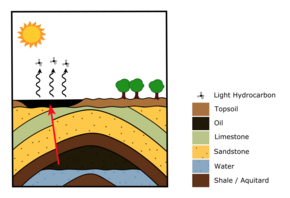Tar pits, sometimes referred to as asphalt pits, are large asphalt deposits. They form in the presence of oil, which is created when decayed organic matter is subjected to pressure underground. If this crude oil seeps upward via fractures, conduits, or porous sedimentary rock layers, it may pool up at the surface.[1] The lighter components of the crude oil evaporate into the atmosphere, leaving behind a black, sticky asphalt.[1] Tar pits are often excavated because they contain large fossil collections.[1]
Tar pits form above oil reserves, and these deposits are often found in anticlinal traps. In fact, about 80 percent of petroleum found on Earth has been found in anticlinal traps.[2] Anticlines are folds in stratigraphic layers in which each half of the fold dips away from the crest. Such structures are usually developed above thrust faults or in tectonic regions where the land is bending and folding. If the structure above the concave-down fold (arch) is a non-porous rock or aquitard, such as shale, it is considered an anticlinal trap.[2] The figure in this section is a cartoon cross-section diagram that shows oil stuck in an anticlinal trap. If there is a fault or fracture in the overlying strata above the oil reserve, the oil may migrate to the surface. This is possible by capillary fringe and because oil is less dense than water.[3]
https://en.wikipedia.org/wiki/Tar_pit
above. You Could be mine guns n roses

No comments:
Post a Comment